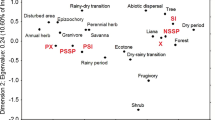Abstract
Recent studies of germination in natural habitats, of genetic variation within populations and of the relative proportion of vegetative and sexual reproduction in the clonal plant speciesAnemone nemorosa suggest that sexual recruitment by seeds from outcrossed flowers is important for the maintenance of this species' populations. Because published reports on its breeding system are controversial, pollination experiments were performed in five natural populations ofA. nemorosa. Differences in ovule number per flower were recorded among populations, but they were not related to obvious habitat differences. Seed/ovule-ratios were significantly higher after open pollination and artificial crossing than after either artificial or spontaneous selfing. Populations had no effect on seed/ovuleratios. Different breeding indices indicated thatA. nemorosa is mainly self-incompatible. Nevertheless, some seed set also occurred after selfing, and both artificial and spontaneous selfing exhibited higher variation in seed/ovule-ratios than open pollination and artificial crossing. Continuous variation in seed/ovule-ratios after selfing suggested that the expression and effectiveness of the self-incompatibility system ofA. nemorosa is influenced by both genetic variation and phenotypic plasticity.
Similar content being viewed by others
References
Arroyo M. T. K., Uslar P. (1993) Breeding systems in a temperate Mediterranean-type climate montane sclerophyllous forest in Central Chile. Bot. J. Linn. Soc. 11: 83–102.
Barrett S. C. H., Harder L. D. (1996) Ecology and evolution of plant mating. Trends Ecol. Evol. 11: 73–79.
Barrett S. C. H., Harder L. D., Worley A. C. (1996) The comparative biology of pollination and mating in flowering plants. Phil. Trans. Roy. Soc. Lond. B 351: 1271–1280.
Baumberger H. (1971) Chromosomenzahlbestimmungen und Karyotypanalysen bei den GattungenAnemone, Hepatica undPulsatilla. Ber. Schweiz. Bot. Ges. 80: 17–95.
Canullo R. (1988) Densità, ritmo stagionale e potenziale generativo di populazioni diAnemone nemorosa L. presso il bacino di Gubbio (Italia Centrale). Webbia 42: 77–99.
Cowie N. R., Watkinson A. R., Sutherland W. (1995) Modelling the growth dynamics of the clonal herbAnemone nemorosa L. in an ancient coppice wood. Abstr. Bot. 19: 35–49.
Dafni A. (1992) Pollination ecology. A practical approach. Oxford University Press, Oxford.
De Nettancourt D. (1977) Incompatibility in angiosperms. Springer, Berlin.
Ehrlén J. (1993) Ultimate functions of non-fruiting flowers inLathyrus vernus. Oikos 68: 45–52.
Ellenberg H. (1996) Vegetation Mitteleuropas mit den Alpen in ökologischer Sicht. Ulmer, Stuttgart.
Ernst W. H. O. (1983) Population biology and mineral nutrition ofAnemone nemorosa with emphasis on its parasitic fungi. Flora 173: 335–348.
Eriksson O. (1995) Seedling recruitment in deciduous forest herbs: the effect of litter, soil, chemistry and seed bank. Flora 190: 65–70.
Grime J. H., Hodgson J. G., Hunt R. (1988) Comparative plant ecology. Unwin Hyman, London.
Hegi G. (1912) Illustrierte Flora von Mitteleuropa, III. Lehmann's Verlag, München.
Holderegger R. (1996) Effect of litter removal on the germination ofAnemone nemorosa L. Flora 191: 175–178.
Holderegger R., Stehlik I., Schneller J. J. (1998) Estimation of the relative importance of sexual and vegetative reproduction in the clonal woodland herbAnemone nemorosa. Oecologia 117: 105–107.
Kao T.-H., McCubbin A. (1996) How flowering plants discriminate between self and non-self pollen to prevent inbreeding. Proc. Natl. Acad. Sci. USA 83: 12059–12065.
Lundqvist A. (1990) The complex S-gene system for control of self-incompatibility in the Buttercup genusRanunculus. Hereditas 113: 29–46.
Proctor M., Yeo P., Lack A. (1996) The natural history of pollination. Harper Collins, London.
Richards A. J. (1997) Plant breeding systems. Chapman and Hall, London.
Ramsey M., Prakash N., Cairns S. (1993) Breeding systems of disjunct populations of Christmas Bell (Blandfordia grandiflora R. Br., Liliaceae): variation in self-fertility and an ovular mechanism regulating self-fertilization. Austr. J. Bot. 41: 35–47.
SAS Institute (1995) SAS user's guide: statistics, version 5. SAS Institute, Cary.
Schmider P., Küpfer M., Tschander B., Käser B. (1993) Die Waldstandorte im Kanton Zurich. Vdf, Zürich.
Schou O. (1983) The distyly inPrimula elatior (L.) Hill (Primulaceae), with a study of flowering phenology and pollen flow. Bot. J. Linn. Soc. 86: 261–274.
Shirreffs D. A. (1985) Biological flora of the British Isles:Anemone nemorosa L. J. Ecol. 73: 1005–1020.
Sokal R. R., Rohlf F. J. (1995) Biometry. Freemann, New York.
Trela-Sawicka Z. (1975) Embryology and biology of reproduction ofAnemone nemorosa L. andA. ranunculoides L. in Poland. Acta Biol. Crac. Ser. Bot. 18: 57–77.
Tumidajowicz D. (1975) Population dynamics ofAnemone nemorosa in the Nieplomice Forest. Bull. Acad. Pol. Sci. 23: 101–108.
Vogler D. W., Das C., Stephenson A. G. (1998) Phenotypic plasticity in the expression of self-incompatibility inCampanula rapunculoides. Heredity 81: 546–555.
Author information
Authors and Affiliations
Rights and permissions
About this article
Cite this article
Müller, N., Schneller, J.J. & Holderegger, R. Variation in breeding system among populations of the common woodland herbAnemone nemorosa (Ranunculaceae). Pl Syst Evol 221, 69–76 (2000). https://doi.org/10.1007/BF01086381
Received:
Accepted:
Issue Date:
DOI: https://doi.org/10.1007/BF01086381




